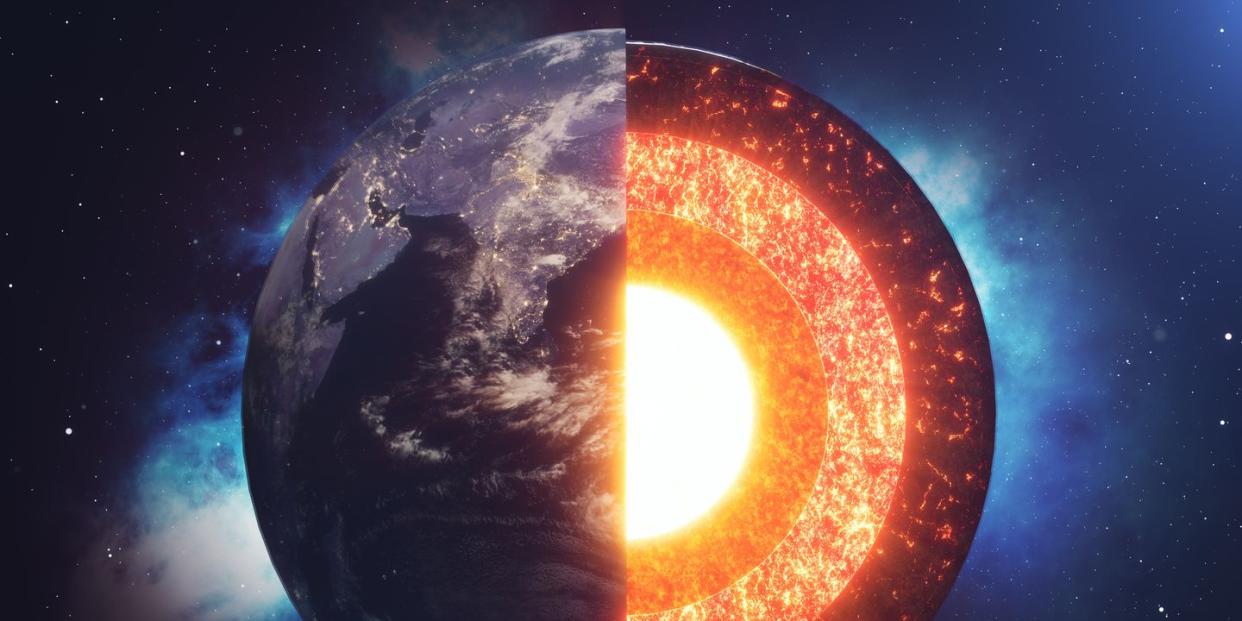Actually, Earth’s Solid Core Isn’t All That Solid

"Hearst Magazines and Yahoo may earn commission or revenue on some items through these links."
That solid iron inner core of Earth may still hold liquid iron, according to a new study from the University of Utah.
Scientists have used seismic waves to research Earth’s inner core, uncovering a wealth of new knowledge about a place we cannot see.
Earth’s inner core seems to remain in a constant state of change.
The greatest center-of-a-Tootsie Pop search continues, as scientists probe Earth’s inner core for more data about its makeup and evolution. The latest discovery—thanks to seismic wave research—shows that the solid iron inner core of Earth may not be fully solid, but contain trapped layers of liquid iron.
In a study published in Nature, a team of University of Utah-lead researchers probed the 1,500-mile-diameter sphere known as the inner core. It makes up only about 1 percent of Earth’s total volume, but is key to understanding Earth’s magnetic field.
The team found liquid iron in a region that was previously believed to hold only solid iron and nickel. “Our biggest discovery is the inhomogeneity tends to be stronger when you get deeper,” lead author Guanning Pang, a former PhD student in the university’s Department of Geology and Geophysics and now a post-doctoral researcher at Cornell University, says in a statement. “Toward the center of the Earth it tends to be stronger.”
These changes come thanks to the growth of the inner core. “A long time ago the inner core grew really fast,” Utah seismologist Keith Koper, who oversaw the study, says in a statement. “It reached an equilibrium, and then it started to grow much more slowly. Not all of the iron became solid, so some liquid iron could be trapped inside.”
We’ve known about some of the interplay between solid iron and liquid iron. While the idea of an inner core was first discovered in 1936 using seismic wave information, we’ve now measured the core about 4,300 miles across. It’s made up of mostly iron and some nickel, along with a few other elements. The liquid outer core envelops the solid inner core.
The liquid outer core, which extends to 1,795 miles above the solid core, Koper says, produces a protective field of magnetic energy. The molten metal cools as it approaches Earth’s rocky mantle and sinks. This circulation generates bands of electrons that envelop the planet. Koper says that without the solid inner core, this field wouldn’t have the strength it does, and Earth’s surface would become bombarded with radiation and solar winds that would make the planet uninhabitable.
“It’s like a planet within a planet that has its own rotation and its decoupled by this big ocean of molten iron,” Koper says.
A recent unrelated study published in Nature Communications claims that there exists an innermost inner core of Earth that is a 400-mile-thick ball of mainly iron. This is smaller and separate from what has long been held as Earth’s inner core.
In the new project from Utah, the team used 20 seismometers stationed around the world, from Wyoming to Antarctica, to analyze seismic waves from 2,455 earthquakes of 5.7 magnitude or greater—strong enough the waves bounced off that inner core—to help map the deepest reaches of Earth.
“The signal that comes back from the inner core is really tiny,” Koper says. “The size is about on the order of a nanometer. What we’re doing is looking for a needle in a haystack. So, these baby echoes and reflections are very hard to see.”
The mapping shows there isn’t a homogeneous inner core, but one that has evolved differently in various spots. The team believes that this shows the trapping of liquid iron inside the solid core.
That would make for quite the exciting Tootsie Pop.
You Might Also Like

